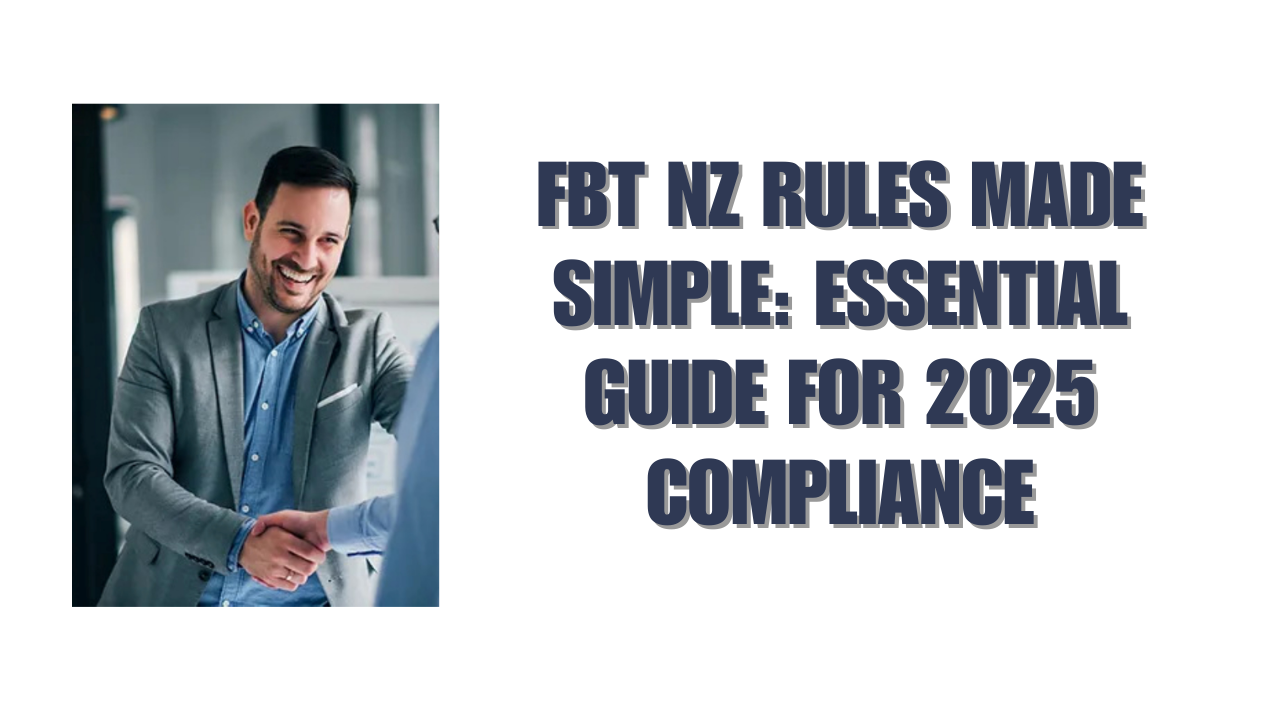The FBT NZ system turns 40 in 2025. Not much has changed since its start in 1985. The system now faces major reforms that will make life easier for businesses of all sizes in New Zealand by cutting compliance costs and making rules simpler.
What’s new with Fringe Benefit Tax NZ in 2025? Businesses should know about the new FBT rates NZ has planned. The differentiated vehicle rates will be 26% for standard vehicles, 22.4% for hybrids, and 19.4% for electric vehicles. The reforms will bump up vehicle weight limits from 3,500 kg to 4,500 kg. A more relaxed ‘close enough is good enough’ approach to compliance is also on the cards.
Let’s walk through these vital updates to the FBT system. You’ll learn how these changes affect your business and what steps you need to take to stay compliant under the new rules. Small business owners and corporate tax specialists alike need to understand these reforms to make the most of their tax strategy in 2025.
Understanding What is Fringe Benefit Tax NZ in 2025
Fringe Benefit Tax serves as the life-blood of New Zealand’s taxation framework and will undergo the most important changes in 2025. Let’s explore what FBT means, recent reforms, and what businesses need to do to comply.
Definition and Purpose of FBT in New Zealand
The government imposes Fringe Benefit Tax on non-cash benefits that employers give their employees beyond standard salary and wages. Employers must pay FBT, unlike income tax which falls on employees. This tax covers five benefit categories: motor vehicles for private use, low-interest or interest-free loans, free or discounted goods and services, employer contributions to various funds (excluding those subject to ESCT), and unclassified fringe benefits.
FBT NZ’s main goal focuses on creating tax equity. The system will give a fair approach to taxing all forms of employee remuneration, not just cash payments. This prevents tax avoidance through non-cash compensation and creates a fairer distribution of tax obligations among workers.
Key Changes Introduced in the 2025 Reform
The 2025 reform represents the biggest update to FBT in 40 years. New FBT thresholds will start from April 1, 2025, with these tax rates:
- 11.73% for benefits valued at NZD 0-23,813.73
- 21.21% for NZD 23,815.44-77,144.75
- 42.86% for NZD 77,146.46-106,515.36
- 49.25% for NZD 106,517.07-222,962.49
- 63.93% for NZD 222,964.20 and above
The reform brings a new alternative rate calculation method starting January 1, 2025. The vehicle weight limit increases from 3,500kg to 4,500kg. New vehicle categories with different FBT rates appear, and businesses can use a “close enough is good enough” approach to compliance.
The entertainment expense regime moves from income tax returns to FBT to match international practices. This change helps reduce confusion and makes administration easier for businesses.
Who Needs to Pay FBT and When
Every employer offering fringe benefits must pay FBT. This includes benefits provided through third parties that come from employment relationships. The tax applies to benefits enjoyed by employees, shareholder-employees, or their associates from employment.
Businesses can choose quarterly or annual returns. Quarterly filers must submit by May 31 for the financial year’s final quarter and January 20, 2026, for the next quarter. Businesses can file or pay on the next business day without penalties if due dates fall on weekends or holidays.
Each business’s filing frequency and potential exemptions depend on their benefit types and values under the reformed system. The core team should evaluate their situation carefully to determine the right approach.
How to Calculate FBT NZ Under the New Rules
The 2025 FBT rules need you to understand several important changes. These new rules make tax calculations quicker while ensuring fair treatment of different benefits.
New Vehicle Categories and Their FBT Rates
The 2025 rules create three vehicle categories with specific FBT rates:
- Category 1 (Perk Vehicles): Subject to 100% FBT rate for unrestricted private use
- Category 2 (Tool-of-Trade): Taxed at 35% when private use is limited
- Category 3 (Business-Only): 0% FBT rate applies when there’s no private use except incidental travel
The taxable value now changes based on what type of fuel you use:
- Petrol/Diesel: 26% (up from current 20%)
- Hybrid: 22.4%
- Electric: 19.4%
Unclassified Benefits: Remuneration Test vs List Approach
You can choose between two options for unclassified benefits:
Remuneration Test: Benefits under NZD 341.12 are exempt if they’re not substitutes for remuneration. This covers flowers, small gifts, and casual recognition items but keeps FBT on higher-value benefits.
List Approach: You get a ready-made list of exempt benefits. This includes one-off prizes below NZD 341.12, token gifts, and flowers for special occasions.
Entertainment Expenses Now Under FBT Scope
Entertainment expenses now fall under FBT instead of income tax. This replaces the current 50% deduction limit. The change matches what happens in Australia and the UK, with a new “entertainment” category taxed at 49.25%.
You can choose between two options:
- Use the NZD 341.12 de minimis exemption for non-remunerative entertainment
- Make food and beverages exempt except at social events
Using the FBT Calculator NZ for Quick Estimates
You can use four methods to calculate your FBT:
- Single rate (63.93%)
- Short form alternate rate
- Full alternate rate
- Pooled alternate rate
Your filing schedule determines which options you can use. Quarterly filers use either the single rate (63.93%) or alternate rate (49.25%) for quarters 1-3. In quarter 4, you must stick with the single rate or switch to full alternate rate calculation.
These new rules make it easier to comply while ensuring employee benefits are taxed appropriately.
Materials and Methods: Filing and Reporting FBT Returns
Filing FBT NZ returns needs you to know several options and processes that have changed with the 2025 updates. The system gives you more flexibility now but needs extra information to help with compliance and make administration easier.
Quarterly vs Annual Filing Options
You can file FBT NZ returns in three different ways: quarterly (IR420), annual (IR422), and income year (IR421) returns. Most employers must file quarterly returns by default unless they qualify for yearly filing.
You can file annual returns from April 1 to March 31 if you give benefits to regular employees (not shareholder employees) and meet one of these conditions:
- Your gross PAYE and ESCT last year was NZD 1,705,610.27 or less
- You didn’t employ anyone in the previous tax year
Income year filing lines up with your income tax period. Close companies can use this option to report benefits for shareholder-employees if they meet these rules:
- Your gross PAYE and ESCT was NZD 1,705,610.27 or less last year
- You only provided up to two company cars for shareholder-employees
- You weren’t an employer last year
Remember to submit annual returns by May 31 and income year returns by your income tax due date.
Electronic Filing Through FBT Software
The 2025 reform lets taxpayers file their FBT returns directly through software to Inland Revenue systems. This switch from paper to electronic filing helps reduce mistakes and makes compliance easier.
Modern software packages help automate and improve FBT compliance with features like:
- Quick calculations and tax optimization
- Clear audit trails and review tools
- Tax rules that update automatically with new regulations
New Data Requirements in FBT Returns
Your FBT returns will need more details soon, such as:
- Different types and sub-types of fringe benefits
- Statements in income tax returns that confirm you followed FBT rules for claimed vehicle expenses
The system also lets employers pay FBT in the first three quarters based on 25% of last year’s amount (adding up to 75% over three quarters). You can then balance everything in the fourth quarter.
Limitations and Special Cases in FBT NZ Guide
The 2025 FBT NZ framework contains several key exceptions and special provisions. These unique elements create boundaries and opportunities for businesses that deal with specific situations or employee categories.
Signwriting Exemptions for Sensitive Professions
The new rules require category 2 and 3 vehicles to display employer signwriting. This helps with enforcement by identifying vehicles that might be used as category 1 perk vehicles. The rules build on existing work-related vehicle requirements, which state that signwriting must be permanent since removable magnetic signage doesn’t meet the standard.
Officials acknowledge that signwriting doesn’t work in every situation. The 2025 reforms then introduce a formal exemption application process, which doesn’t exist in current regulations. This benefits professionals in sensitive roles especially when you have security risks or privacy concerns from vehicle identification.
FBT Rules for Major Shareholder-Employees
The new framework imposes tighter restrictions on major shareholder-employees. We limited those with 25%+ shareholding to employ category 2 or 3 rates only for vehicles costing less than NZD 136,448.82. This ceiling stops people from classifying luxury vehicles as business-only to dodge proper taxation.
Close companies that provide vehicles to shareholder-employees have specific choices. They can:
- Apply motor vehicle expenditure rules instead of FBT rules
- Use income statement adjustments rather than filing regular FBT returns
- Apportion vehicle expenses based on actual business versus private use (with logbook records)
These rules apply only to companies with one or two motor vehicles that offer no other fringe benefits.
Treatment of Global Insurance and Stored Value Cards
The 2025 reforms clarify the treatment of previously unclear benefits. Both open and closed loop stored value cards now fall under FBT instead of PAYE. This change aligns with recent Inland Revenue’s interpretation of trade rebates and gift cards.
Global insurance policies now have standardized treatment. Officials suggest two ways to calculate: divide total cost by employee count or treat the policy as a pooled benefit. This mandatory approach removes previous inconsistencies in businesses’ FBT calculations for such policies.
Conclusion
New Zealand’s tax world is undergoing complete FBT reforms. These changes optimize compliance and you retain control of tax equity through separate vehicle rates, simpler calculation methods, and clearer exemption guidelines.
Here are the most important updates starting April 2025:
- Three-tier vehicle categorization with rates from 19.4% to 26%
- Updated FBT thresholds and calculation methods
- Electronic filing options through approved software
- Special provisions for shareholder-employees
- Standardized treatment of global insurance and stored value cards
Business owners now have more flexibility with quarterly or annual filing options. The “close enough is good enough” approach reduces administrative work without affecting tax integrity.
The switch from paper-based returns to electronic filing and precise benefit categories creates a faster tax framework. These updates line up New Zealand’s FBT system with international standards and fix compliance issues that businesses don’t deal very well with.
Your business needs to understand these reforms to optimize tax strategies and stay compliant in 2025 and beyond. Take time to review your current FBT practices. Update your systems to get the most from these optimized regulations.
FAQs
Q1. What are the key changes to FBT in New Zealand for 2025?
The 2025 FBT reform introduces new vehicle categories with different rates (26% for standard, 22.4% for hybrid, 19.4% for electric), increases vehicle weight limits to 4,500 kg, and shifts entertainment expenses from income tax to FBT. It also offers new calculation methods and electronic filing options.
Q2. How often do businesses need to file FBT returns?
Businesses can file FBT returns quarterly or annually, depending on their circumstances. Quarterly filing is the default, but annual filing is available for businesses providing benefits to ordinary employees if their gross PAYE and ESCT for the previous year were NZD 1,705,610.27 or less.
Q3. Are there any exemptions from FBT for certain types of benefits?
Yes, there are exemptions for minor benefits valued under NZD 341.12 that are not provided as remuneration substitutes. The reform also introduces a potential “List Approach” that may exempt specific items like one-off prizes, token gifts, and flowers for special occasions.
Q4. How does the new FBT system handle company vehicles?
The 2025 reform introduces three vehicle categories: Perk Vehicles (100% FBT rate), Tool-of-Trade (35% FBT rate), and Business-Only (0% FBT rate). The taxable value calculation also varies based on the vehicle’s fuel type, with different rates for petrol/diesel, hybrid, and electric vehicles.
Q5. What special provisions apply to shareholder-employees under the new FBT rules?
Major shareholder-employees (25%+ shareholding) face stricter limitations, such as only being able to use category 2 or 3 rates for vehicles with a cost base below NZD 136,448.82. Close companies providing vehicles to shareholder-employees have options like applying motor vehicle expenditure rules instead of FBT rules or using income statement adjustments.






